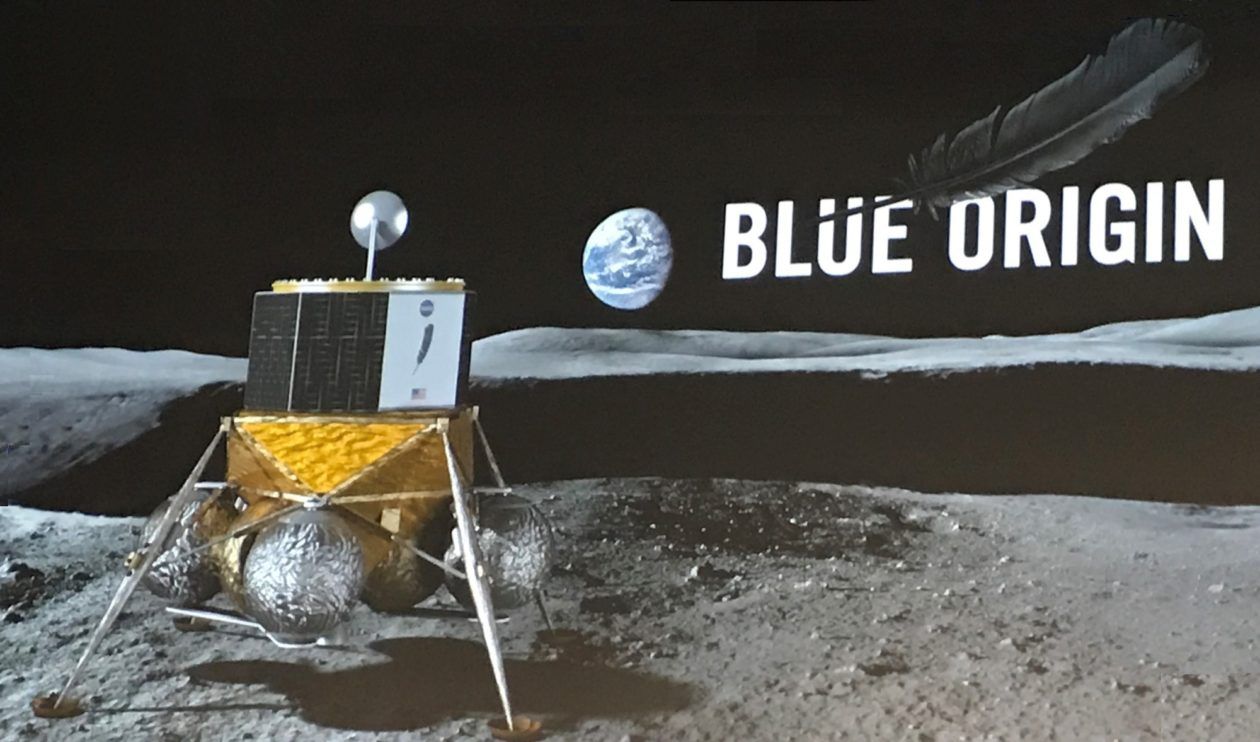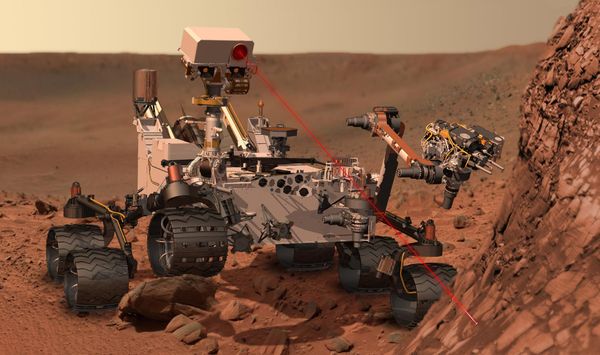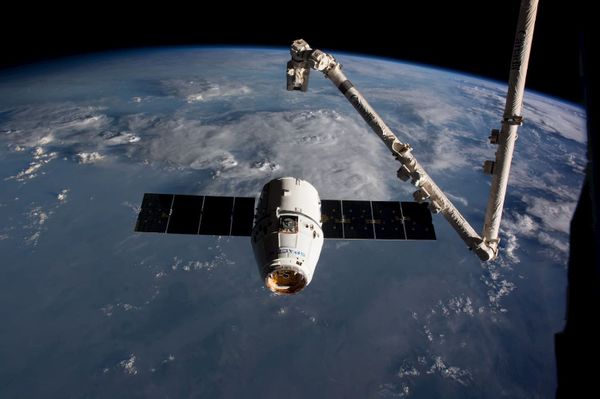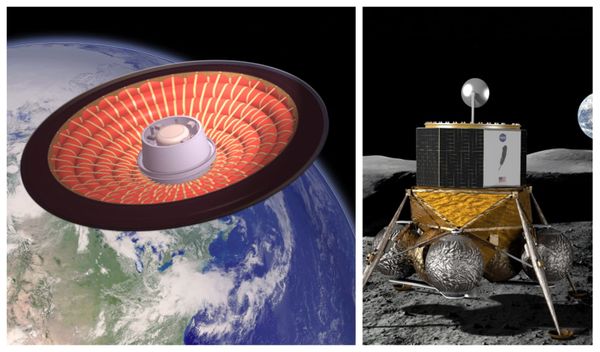Subscribe on iTunes, Google Play, or by RSS for more space exploration discussions. (Banner image courtesy of Blue Origin via Geekwire)
This week seemed like a pretty slow week in space news, until the very last moment, when two large events resulted in a deluge of interesting news items. Our original topic, an update on the SPEX High Altitude Balloon project, is recorded and will be releasing in a few weeks.
MIT New Space Age Conference
Beyond the Cradle 2018: Track A (Industry talks) - MIT Media Lab
null
Blue Origin
Dr. Erika Wagner, Business Development Manager, and Rob Meyerson, Program Manager and Aerospace Business leader, were at the conference representing Blue Origin.
Blue Origin announced a potential LEO-Lunar orbit tug similar to ACES in the Cislunar-1000 vision by ULA.
Blue Origin’s Rob Meyerson in closing panel: going back to the Moon is extremely exciting. In early to mid 2020s would love to put a lander there, with people following. #spaceexploration
— Jeff Foust (@jeff_foust) March 10, 2018
Meyerson says Blue Origin, in addition to the Blue Moon lander concept, is also looking at reusable tugs for transport between LEO and the Moon. #spaceexploration
— Jeff Foust (@jeff_foust) March 10, 2018
They also talked about their timeline for beginning New Shepard flights later this year.
Meyerson: we’re going to enter the human spaceflight market later this year. #spaceexploration
— Jeff Foust (@jeff_foust) March 10, 2018
However, it will be over a decade before New Glenn sends humans into orbit on their new rocket, New Glenn
Mayerson: early New Glenn launches will be payloads; might be 7-8 years before start launching people on that orbital vehicle. Will need to increase the launch rate (initially 12/year) significantly. #spaceexploration
— Jeff Foust (@jeff_foust) March 10, 2018
Blue Origin also talked about their engine development programs.
Rob Meyerson shows this chart of the various engines Blue Origin has developed and the vehicle that have used, or will use, them. #spaceexploration pic.twitter.com/YZ3EnqIE4E
— Jeff Foust (@jeff_foust) March 10, 2018
Meyerson: BE-3 engine is cornerstone of our vehicle development; we expect to be iterating on its design 50 years from now. #spaceexploration
— Jeff Foust (@jeff_foust) March 10, 2018
Audience member asks when Blue Origin might be profitable. Wagner: we are moving from R&D to operations, but our horizons are long, and we’re lucky to have patient capital.
— Jeff Foust (@jeff_foust) March 11, 2018
Erika Wagner of Blue Origin notes when she joined the company six years ago, it had about 170 employees. Now up to 1,400 employees - Jeff Foust, in a now deleted tweet
Its always interesting to compare the scale, timeline, and motivation of New Space companies. Blue Origin has been around for 18 years, and keeps progress close at hand. Compared to SpaceX, with over 6,000 employees, and United Launch Alliance, with around 3,000 employees, Blue Origin is a relatively small competitor. However, their backing by Jeff Bezos gives them an advantage by removing time and profit pressures from the company. Its somewhat of a tortoise and hare kind of race. Stay tuned for more on these two companies in a future episode.
Shotwell: I was the 7th employee at SpaceX. We’re up to about 7,000 now. #NewSpaceEurope
— Jeff Foust (@jeff_foust) November 16, 2017
Swarm Technologies illegally launches satellites
We also talked about one of the first ever cases of commercial satellites being illegally launched into space. Although the launch occured on January 12th, news of the illegal satellites broke during the conference. Several New Space companies took the opportunity to comment on the event.
At the MIT New Space Age Conference today, where the issue of Swarm’s launch of non-FCC-authorized picosats came up during a panel discussion this morning.
— Jeff Foust (@jeff_foust) March 11, 2018
Nobu Okada, Astroscale: “very angry” about this case; not responsible to launch such small, untrackable satellites. Don’t know how that happened.
— Jeff Foust (@jeff_foust) March 11, 2018
Katherine Monson, KSAT: this is a particularly troubling case. FCC has provided great support to the industry, but this does not incentivize such cooperation.
— Jeff Foust (@jeff_foust) March 11, 2018
We found their comments interesting, especially since there has been a lot of talk of changing the regulatory structure for space flights. Specifically, the second meeting of the National Space Council was primarily focused on regulatory reform.
Planetary Resources
Chris Lewicki, CEO and Founder of Planetary Resources took the stage to talk about the changing role of 'space companies'. We discussed how this attitude shift away from 'space company', to 'company that does business in space' has formed due to the explosion of new space startups in recent years. We also discussed the role of validating flight technology in space engineering programs.
Chris Lewicki, Planetary Resources: we’re at a historic inflection point in space, with technological innovation and increasing markets; politics “is starting to catch up” as well. #spaceexploration
— Jeff Foust (@jeff_foust) March 10, 2018
Lewicki: we’re not a space company. We’re using the tools of space industry to do business of a mining or energy company, which have long timelines for their projects. #spaceexploration
— Jeff Foust (@jeff_foust) March 10, 2018
Lewicki: flew midwave infrared sensor on Arkyd-6 satellite launched in January; have demonstrated that it works in space. #SpaceExploration
— Jeff Foust (@jeff_foust) March 10, 2018
Sierra Nevada Corporation and Dream Chaser
Greg Burgess, VP of Technology of the Space Systems Group of SNC was at the conference to talk about their unmanned cargo vehicle, Dream Chaser.
Gregg Burgess, Sierra Nevada Corp.: 85–95% of Dream Chaser mission costs is the launch. Various companies, including ULA, working to reduce launch costs. “Multiple companies” around the world proposing to do future Dream Chaser launches after the first two on Atlas 5.
— Jeff Foust (@jeff_foust) March 11, 2018
We discuss whether Dream Chaser will switch its launch vehicle from the Atlas V to another comparable vehicle. Also we discuss whether that, now that Dragon 2 will not land propulsively, does the Dream Chaser have the opportunity to corner the market on reusability with its gently spaceplane reentry method.
Special Thanks to Jeff Foust for his on-location reporting of the New Space Age Conference
SXSW: Elon Musk Q&A and 'Why Falcon Heavy & Starman'
Life cannot just be about solving one sad problem after another. There need to be things that inspire you, that make you glad to wake up in the morning and be part of humanity. That is why we did it. We did for you - Elon Musk via Twitter
The weekend brought some exciting SpaceX news when Elon Musk made a somewhat surprise appearance at SXSW, crashing the Westworld panel there. He unveiled a video titled Falcon Heavy and Starman which artfully showed the entire process of launching the first Falcon Heavy rocket. We got to see excellent shots of payload encapsulation, rollout, as well as the rumored center core crash footage. The center core just missed hitting the Autonomous Spaceport Drone Ship (ASDS) Of Course I Still Love You, instead crashing into the ocean, generating an explosion that damaged several of its engine pods.
At a standalone Q&A the next day, Elon mentioned a few updates and confirmations on the Big F**king Rocket, or BFR.
Musk: People have told me that my timelines historically have been optimistic. I am trying to recalibrate. What I do know is we are building the first ship. We will be able to do do short flights in the first half of next year. It's a big booster and ship. Saturn V thrust x2.
— Michael Baylor (@nextspaceflight) March 11, 2018
This is interesting, in that it confirm his timeline mentioned after the Falcon Heavy launch, however it appears work on BFR is still a small part of SpaceX's overall development efforts.
Paul Wooster of SpaceX gave a brief overview of BFR development. Noted work on it is still a “relatively small activity” at SpaceX for now, but will be increasing over time with shift of resources currently devoted to Falcon and Dragon. #spaceexploration
— Jeff Foust (@jeff_foust) March 10, 2018
At MIT's New Space Age conference, Paul Wooster, Principal Mars Development Engineer of SpaceX downplayed the scope of BFR development at SpaceX. It will be interesting to see if this focus shifts, now that Falcon 9 is entering its supposedly final Block 5 form, and Crew Dragon set to take flight later this year. Hopefully this timeline holds better than Falcon Heavy ever did.
Musk: A BFR flight will cost less than the Falcon 1. It will be less than $5-6 million per flight.
— Michael Baylor (@nextspaceflight) March 11, 2018
This comment from Musk is interesting, since it gives us a price floor for BFR flights. For a 100 person flight, like what was depicted heading towards Mars, flight cost per passenger is roughly $60,000. That is lower than the dirt cheap price of $200,000 presented at IAC. That does not take into account the cost of supporting a Mars mission or potential costs of surface living on another planet. It also puts the future of BFR as an Earth-based point to point transport service into question. If BFR can handle 300 passengers for an hour, on a similar scale to an Airbus A380, then the mean cost of service is around $17,000. Very expensive compared to most transcontinental flights. That does not include profit, transportation from cities to ocean-based launch sites, and other costs.







